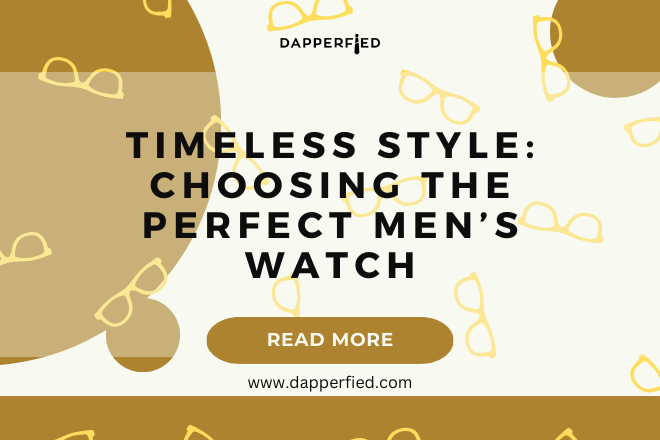
Men's Style
Men’s Watch Selection Tips: Finding the Perfect Timepiece
When it comes to choosing a watch, it’s important to consider your personal style and needs. Are you looking for a watch that is more casual and sporty, or do you need something more formal and elegant? Consider the types of activities you will be wearing the watch for. If you lead an active lifestyle and enjoy outdoor activities, a durable and water-resistant watch may be more suitable for you. On the other hand, if you need a watch for professional or formal occasions, a sleek and sophisticated design may be more appropriate. Additionally, think about the colors and materials that best complement your wardrobe. If you tend to wear a lot of earth tones, a watch with a brown leather strap and a bronze case may be a good fit. If you prefer a more modern and minimalist look, a stainless steel watch with a black dial could be the perfect choice. Understanding your style and needs will help you narrow down your options and make a more informed decision when selecting a watch.
Furthermore, consider the features that are important to you. Do you need a watch with a chronograph function, a date display, or a rotating bezel? Are you interested in a watch with additional complications such as a moon phase or a GMT function? Understanding the features that are essential to you will help you prioritize your preferences and find a watch that meets your specific requirements. For example, if you travel frequently, a watch with multiple time zones may be beneficial. If you are an avid diver, a watch with a reliable water resistance rating and a unidirectional bezel for tracking dive time could be crucial. By understanding your style and needs, as well as the features that are important to you, you can narrow down your options and focus on finding the perfect watch for you.
Key Takeaways
- Understanding your personal style and needs is crucial in choosing the right watch for you.
- Setting a budget will help narrow down your options and prevent overspending.
- Researching different brands and models will give you a better understanding of the available options in the market.
- Considering the movement type, whether it’s quartz, mechanical, or automatic, will impact the watch’s performance and maintenance.
- Choosing the right size and fit is important for comfort and aesthetics.
- Evaluating the features and functions of the watch will help determine if it meets your specific requirements.
- Seeking professional advice and recommendations from watch experts can provide valuable insights and guidance in making your decision.
Setting a Budget
Setting a budget is an important step in the process of buying a watch. Watches come in a wide range of prices, from affordable options to luxury timepieces with hefty price tags. Before you start shopping, it’s essential to determine how much you are willing to spend on a watch. Consider your financial situation and how much you are comfortable investing in a timepiece. Keep in mind that setting a budget doesn’t mean you have to compromise on quality or style. There are plenty of reputable brands that offer high-quality watches at various price points. By setting a budget, you can narrow down your options and focus on finding a watch that not only meets your style and functional needs but also fits within your financial means.
Additionally, when setting a budget, consider the long-term value of the watch. While it may be tempting to opt for the cheapest option available, it’s important to remember that quality often comes with a price. Investing in a well-crafted and durable watch may save you money in the long run, as it is likely to last longer and require fewer repairs or replacements. On the other hand, if you are looking for a fashion-forward watch to complement specific outfits or trends, you may be more inclined to prioritize style over longevity. By setting a budget that aligns with your financial situation and long-term value considerations, you can make a more informed decision when purchasing a watch.
Researching Different Brands and Models
Before making a decision on which watch to purchase, it’s crucial to research different brands and models to find the best fit for your needs. There are countless watch brands on the market, each with its own unique style, heritage, and reputation for quality. Some brands are known for their innovative technology and modern designs, while others are celebrated for their timeless elegance and traditional craftsmanship. By researching different brands, you can gain insight into their history, values, and the types of watches they offer. This will help you identify which brands align with your personal style and preferences.
Furthermore, take the time to explore the various models offered by different brands. Each model may have its own distinct features, functions, and design elements that set it apart from others in the brand’s lineup. Consider the materials used, the movement type, and any special complications or functions that may be of interest to you. Pay attention to customer reviews and feedback to gain an understanding of the overall quality and performance of each model. By researching different brands and models, you can make an informed decision based on your specific style and functional needs.
In addition, consider the reputation of the brand in terms of customer service and after-sales support. A reputable brand will often provide warranties, servicing options, and customer assistance to ensure that your watch remains in optimal condition over time. By researching different brands and models thoroughly, you can feel confident in your decision and find a watch that not only meets your expectations but also offers peace of mind in terms of support and service.
Considering the Movement Type
| Movement Type | Frequency | Duration | Intensity |
|---|---|---|---|
| Walking | 5 times a week | 30 minutes | Moderate |
| Running | 3 times a week | 45 minutes | High |
| Cycling | 2 times a week | 60 minutes | Moderate |
The movement type is an essential factor to consider when choosing a watch. There are three main types of movements: quartz, mechanical, and automatic. Each movement type has its own unique characteristics and performance attributes that may appeal to different individuals based on their preferences and needs.
Quartz movements are powered by a battery and are known for their accuracy and low maintenance requirements. They are often favored for their reliability and affordability. Quartz watches are an excellent choice for those who prioritize precision and convenience in their timepieces.
On the other hand, mechanical movements are powered by a mainspring and require regular winding to keep them running. They are admired for their intricate craftsmanship and traditional appeal. Mechanical watches often appeal to enthusiasts who appreciate the artistry and heritage of traditional watchmaking.
Automatic movements are similar to mechanical movements but feature a self-winding mechanism that eliminates the need for manual winding. They are favored for their convenience and blend of traditional craftsmanship with modern technology. Automatic watches are ideal for those who appreciate the charm of mechanical movements but desire added convenience.
When considering the movement type, think about your lifestyle and preferences. If you prefer low-maintenance timepieces with precise timekeeping, a quartz movement may be the best choice for you. If you have an affinity for traditional craftsmanship and enjoy the ritual of winding a watch, a mechanical movement may be more appealing. If you value convenience without sacrificing the charm of traditional movements, an automatic movement could be the perfect fit.
Choosing the Right Size and Fit
Choosing the right size and fit is crucial when selecting a watch that not only looks good but also feels comfortable on your wrist. Watches come in various case diameters and thicknesses, as well as different strap lengths and widths. It’s important to consider these dimensions to ensure that the watch complements your wrist size and proportions.
Firstly, consider the case diameter of the watch. A larger case diameter may make a bold statement on larger wrists but could overwhelm smaller wrists. Conversely, a smaller case diameter may appear dainty on larger wrists but could be more proportionate on smaller wrists. Pay attention to how the case diameter interacts with your wrist size to find a balanced fit that suits your personal style.
Additionally, consider the thickness of the case. A thicker case may have a more substantial presence on the wrist but could feel cumbersome or bulky for some individuals. A thinner case may offer a sleeker profile but could lack the visual impact desired by others. Finding the right balance between case diameter and thickness is essential for achieving both comfort and aesthetics.

Furthermore, pay attention to the strap length and width. A strap that is too long may result in excess material flapping around your wrist, while a strap that is too short may feel tight or uncomfortable. Similarly, a strap that is too wide may overpower smaller wrists, while a strap that is too narrow may appear insubstantial on larger wrists. Finding the right combination of strap length and width will ensure that the watch sits comfortably on your wrist while maintaining visual harmony.
By choosing the right size and fit for your watch, you can enhance both its appearance and wearability. A well-proportioned watch will not only look stylish but also feel comfortable for everyday wear.
Evaluating the Features and Functions

When evaluating different watches, it’s important to consider the features and functions that are essential to your lifestyle and preferences. Watches come with various complications and additional functions that can enhance their utility and appeal. Some common features include chronographs for timing events, date displays for tracking the calendar, GMT functions for monitoring multiple time zones, and moon phase indicators for celestial enthusiasts.
Consider which features are important to you based on your daily activities and interests. If you frequently time events or workouts, a chronograph function may be beneficial. If you travel often or communicate with individuals in different time zones, a GMT function could be useful. If you appreciate celestial phenomena or simply enjoy tracking lunar phases, a moon phase indicator may add an intriguing dimension to your watch.
Furthermore, consider any additional functions that may enhance the practicality of the watch. Some watches offer water resistance for aquatic activities, luminous hands and markers for low-light visibility, or tachymeter scales for measuring speed over distance. These functions can add versatility and convenience to your timepiece based on your specific needs.
In addition to considering functional features, evaluate any aesthetic elements that contribute to the overall appeal of the watch. This could include decorative engravings, textured dials, exhibition case backs for viewing the movement, or unique materials such as mother-of-pearl or meteorite dials. By evaluating both functional features and aesthetic details, you can find a watch that not only meets your practical requirements but also resonates with your personal style.
Seeking Professional Advice and Recommendations
Seeking professional advice and recommendations can provide valuable insights when choosing a watch. Watch experts at reputable retailers or authorized dealers can offer guidance based on their knowledge of different brands, models, movements, features, and sizing considerations. They can help you navigate through various options based on your style preferences, functional needs, and budget constraints.
Additionally, professional advice can help you understand the long-term value of different watches in terms of quality, craftsmanship, after-sales support, servicing options, warranties, and resale potential. By consulting with experts in the field, you can gain confidence in your decision-making process and make an informed investment in a timepiece that aligns with your expectations.
Furthermore, seeking recommendations from friends or family members who have experience with watches can provide valuable firsthand insights into different brands and models. They can share their personal experiences with specific watches in terms of durability, performance, comfort, and overall satisfaction.

In addition to seeking professional advice from retailers or friends/family members who are watch enthusiasts themselves, consider joining online forums or communities dedicated to watches. These platforms provide opportunities to engage with fellow enthusiasts who can offer advice based on their experiences with different watches.
By seeking professional advice and recommendations from knowledgeable sources within the industry as well as fellow enthusiasts, you can gain valuable perspectives that will help you make an informed decision when purchasing a watch.
Additionally, conducting thorough research on different watch brands, models, and features will also provide you with the necessary information to make a well-informed decision. Understanding the various materials, movements, and complications available in the market will allow you to narrow down your options and find a watch that best suits your style, budget, and preferences. Taking the time to educate yourself about the intricacies of watchmaking will ultimately lead to a more satisfying and rewarding purchase.
If you’re looking for more style tips for men, be sure to check out Dapperfied’s article on creating the perfect man cave. Whether you’re looking to upgrade your watch collection or revamp your living space, Dapperfied has you covered with expert advice and inspiration. https://www.dapperfied.com/man-cave/
FAQs
What are the important factors to consider when selecting a watch for men?
Some important factors to consider when selecting a watch for men include the style, size, material, movement, and features of the watch.
What are the different styles of watches for men?
There are various styles of watches for men, including dress watches, sports watches, dive watches, pilot watches, and chronograph watches.
What are some popular materials used in men’s watches?
Popular materials used in men’s watches include stainless steel, titanium, leather, rubber, and ceramic.
What are the different types of watch movements available for men’s watches?
The different types of watch movements available for men’s watches include quartz, mechanical, and automatic movements.
What are some important features to look for in a men’s watch?
Some important features to look for in a men’s watch include water resistance, chronograph functions, date display, and luminous hands and markers.
How can I determine the right size of watch for a man?
The right size of a watch for a man can be determined by considering the size of the man’s wrist and his personal style preferences. It’s important to ensure that the watch fits comfortably on the wrist.















